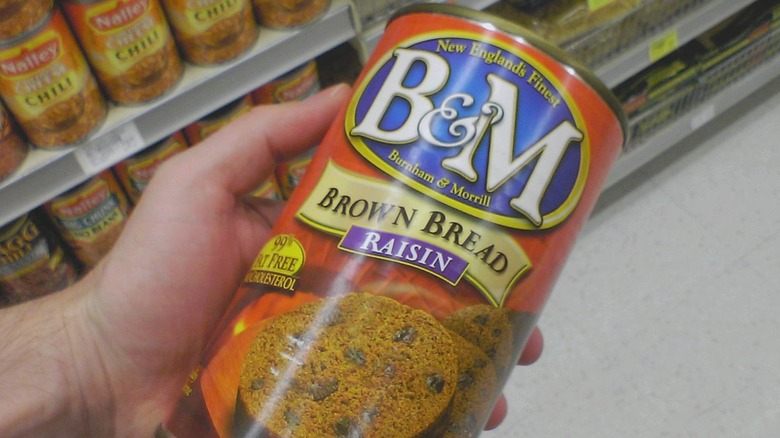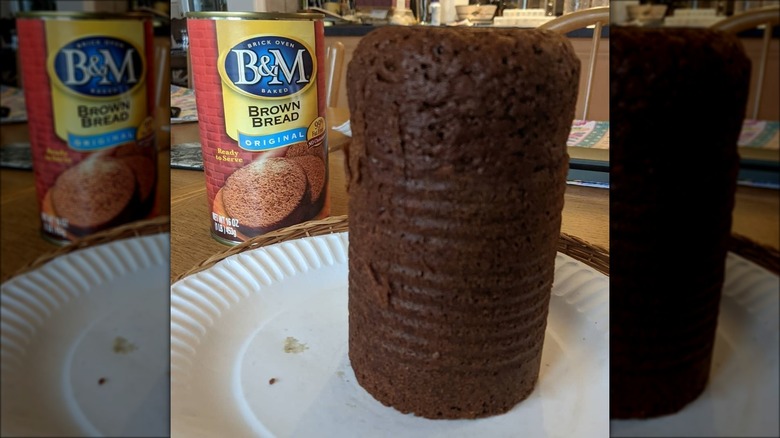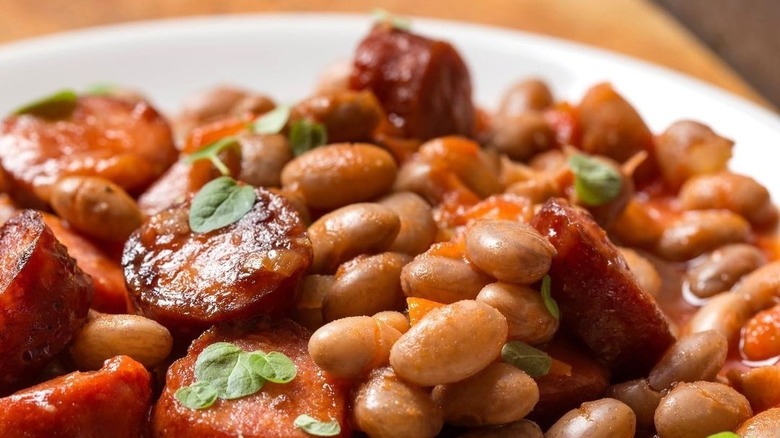How Canned Bread Became A New England Favorite
When it comes to food nostalgia, canned brown bread takes the cake — at least in New England. For many of us, it was a staple on the Saturday night dinner table, right alongside Boston baked beans, and grilled hot dogs. While naysayers may scoff at the very mention of canned bread, those of us in the know remember slathering fresh butter onto warm slices of the rich molasses bread (sometimes it was speckled with raisins) and letting it melt just enough to be drippy but not messy, before taking the first bite that inevitably transported us to culinary nirvana.
Little did we know then, but the canned brown bread so central to our Saturday night suppers was rooted in Colonial tradition. Long before it became a beloved canned specialty lining the shelves of 20th-century grocery stores, New England-style brown bread was the poor man's alternative to wheat bread, derived from third bread (a traditional loaf made using equal parts of wheat, rye, and cornmeal). Fast forward a couple hundred years to Portland, Maine where food purveyor B&M (named after its founders George Burnham and Charles Morrill) decided to add a new item to its product roster. The company introduced canned New England brown bread in 1927.
The bread inside the can
The modern-day evolution of brown bread began in the 17th century when European immigrants who settled in the northeastern quadrant of the United States realized the region was unsuitable for growing wheat and importing wheat from Europe was just too expensive. So, they made do with alternate grains to make other varieties of flour. Wheat may have been scarce, but corn flourished in the New England climate, as did rye. So, the settlers pivoted, making bread using a blend of cornmeal and rye flour.
Wheat eventually made its way back into the mix when the opening of the Erie Canal expedited trade between the Northeast and the Great Plains, where wheat crops thrived. Molasses, a low-cost sweetener compared to sugar, became a standard ingredient in the mid-18th century. The result was a dark, dense, moist, almost cakelike bread with a texture similar to a traditional British steamed pudding. The similarity is not a coincidence. Long before it became a canned convenience food lining the shelves of 20th-century grocery stores, home-cooked New England brown bread was steamed over a fire, not baked like a traditional bread. Exactly why settlers adopted the alternate cooking method is not entirely clear. One theory suggests the steaming method was initially employed by cooks who didn't have access to ovens, so cooking over an open fire was the best option.
Building on tradition
Regardless of its origins, the practice of steaming New England brown bread translated perfectly to B&M's mass-produced canned variety. By the 1920s, home cooks were routinely steaming (in the oven or stovetop) home-made brown bread, pouring the batter into empty coffee cans to cook in a hot-water bath. See the connection? Bread in a can was already a thing long before B&M decided to distribute it, so it wasn't much of a leap for New Englanders who grew up eating home-cooked brown bread to opt for the convenience of the canned variety. And it was even less of a stretch to incorporate it into a meal plan that included baked beans. After all, B&M's already well-known brand was right there on the same shelf.
How did the hot dogs get into the mix? We're not sure, but it's reasonable to posit that canned brown bread was an easy addition to another long-established New England supper: franks 'n' beans. We'd be remiss if we didn't mention that canned brown bread is absolutely delicious on its own. But first, you have to get to it.
The best way to remove the bread from the can is to open both ends and push it through from one side to the other. It's similar to opening a can of jellied cranberry sauce. Some fans simply slice and eat, but we think it's even better served warm with butter or a schmear of cream cheese. Feeling adventurous? Try making your own – maybe even in a rice cooker.


